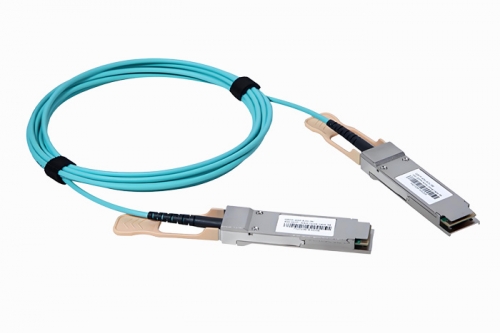What is 10G SFP+ AOC active optical cable?

In the field of optical communications, with the ever-increasing demand for data transmission, traditional copper cables are unable to meet the requirements for high bandwidth, low latency, and long-distance transmission. To solve this, active optical cables (AOCs) have emerged as a mainstream solution in modern data centers, high-performance computing, and network communications. As a key component of this technology, 10G SFP+ AOC active optical cables, with their superior performance and cost-effectiveness, are widely used in short-distance, high-speed data transmission scenarios. This article will provide a detailed introduction to the definition, characteristics, and application scenarios of 10G SFP+ AOC active optical cables, as well as a comparison with DAC high-speed cables, to help you better understand this technology.
An AOC active optical cable is a type of communication cable that requires external energy for optical-to-electrical conversion during communication. Optical transceivers at each end of the cable convert electrical signals into optical signals (or vice versa) for transmission over optical fiber. 10G SFP+ AOC active optical cables (AOCs) are cables that operate at speed rate 10Gbps and utilize the SFP+ form factor. They operate at an 850nm wavelength and are suitable for transmission over multimode fiber (MMF), with a maximum transmission distance of up to 300 meters (on OM3 MMF). These cables not only offer high-speed transmission capabilities but also significant advantages such as compact size, light weight, EMI resistance, and low power consumption.
Features of 10G SFP+ AOC Active Optical Cables
The 10G SFP+ AOC active optical cable offers the following outstanding design and performance features:
High-speed transmission: Supports 10Gbps transmission rates, meeting the high-bandwidth demands of data centers and enterprise networks.
Long-distance transmission: Transmission distances of up to 300 meters on OM3 multimode fiber far exceed the 7-meter limit of traditional copper cables (DACs).
Immune to electromagnetic interference: Due to its fiber-optic transmission, it is unaffected by electromagnetic interference (EMI), ensuring stable and reliable data transmission.
Low Power Consumption and Heat Dissipation: Power consumption is typically between 1-2W, significantly lower than traditional optical module solutions, and the excellent heat dissipation performance makes it suitable for high-density deployments.
Small Size and Light Weight: AOCs are significantly smaller and lighter than copper cables, making them easier to route and maintain, a significant advantage in space-constrained data center environments.
High Reliability: The optical modules at both ends of the AOC cable connect directly to the optical fiber, eliminating interface contamination and improving system stability and reliability.
Application Scenarios
10G SFP+ AOC active optical cables are widely used in the following scenarios:
Data Centers: They are used for short-distance, high-speed interconnects between servers, switches, and storage devices, particularly within racks and across adjacent racks, providing a high-density, low-power solution.
High-Performance Computing (HPC) Clusters: For compute-intensive tasks, AOCs provide low-latency, high-bandwidth data transmission channels, meeting the high-speed communication needs of devices within the cluster.
Network Communications: They are suitable for network communications such as 10G Ethernet, 4G, and 8G Fibre Channel, supporting long-distance, high-speed transmission while reducing electromagnetic interference.
Comparison of 10G SFP+ Active Optical Cable (AOC) and 10G Direct Attach Cable (DAC)
For short-distance transmission, 10G SFP+ Active Optical Cable (AOC) and 10G Direct Attach Cable (DAC) are two common options. Below is a comparison:
Transmission Distance: AOCs have a transmission distance of up to 300 meters, while DACs typically only support transmission distances of less than 7 meters.
Transmission Medium: AOCs use optical fiber, which is immune to electromagnetic interference; DACs use copper cables, which are susceptible to electromagnetic interference.
Power Consumption: AOCs consume 1-2W, slightly higher than DACs (passive DACs consume close to 0W, while active DACs consume less than 1W).
Size and Weight: AOCs are approximately one-quarter the size and half the weight of DACs, making them easier to route and transport.
Cost: AOCs are generally more expensive than DACs, but their advantages in long-distance transmission and interference resistance make them more cost-effective in certain scenarios.
When choosing a cable, consider the following trade-offs based on your specific needs:
If the transmission distance is within 5 meters and cost and power consumption are stringent, DAC is an option.
If the transmission distance is between 5 and 100 meters and electromagnetic interference resistance and lightweight cabling are required, AOC is a better choice.
Conclusion
As an efficient and stable short-distance transmission solution, 10G SFP+ AOC active optical cables, with their high-speed transmission, long-distance coverage, interference resistance, and low power consumption, have become an ideal choice for data centers, high-performance computing, and network communications. Compared to DAC high-speed cables, AOC offers advantages in transmission distance and interference resistance, making it particularly suitable for interconnection needs within the 5 to 100 meter range. As data transmission demands continue to grow, 10G SFP+ AOC active optical cables will play an increasingly important role in the future optical communications market.
 Send Email
Send Email wx19842017
wx19842017